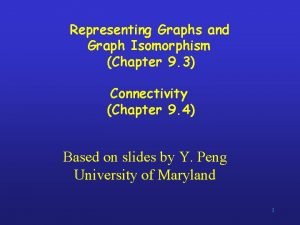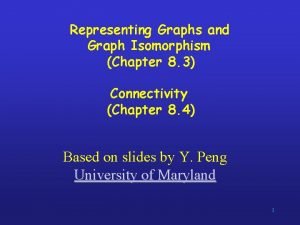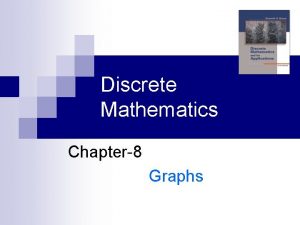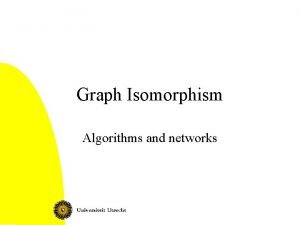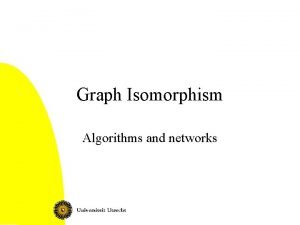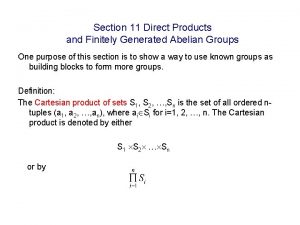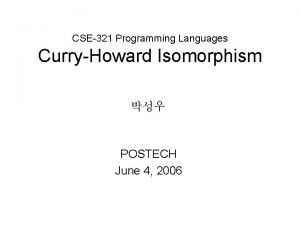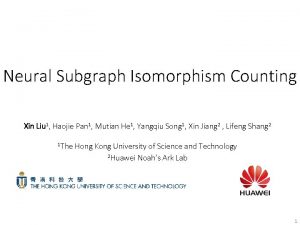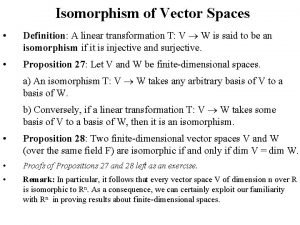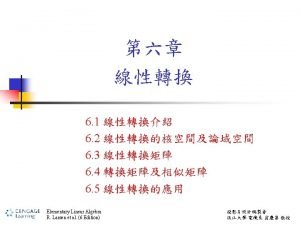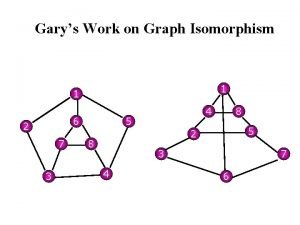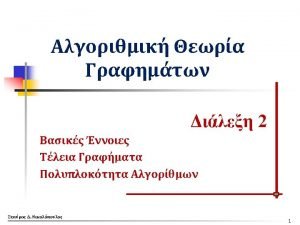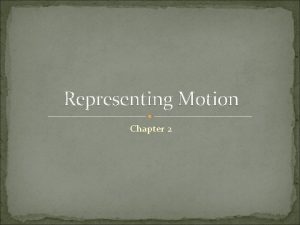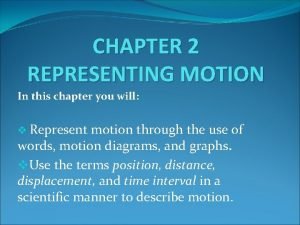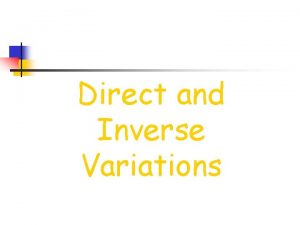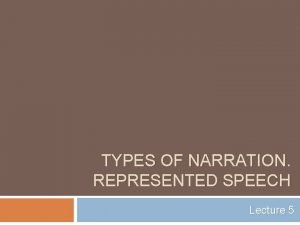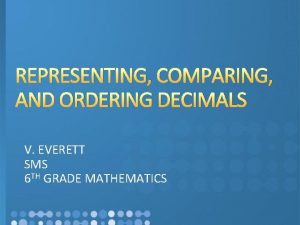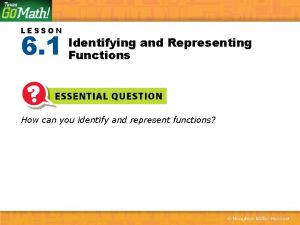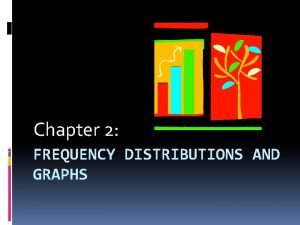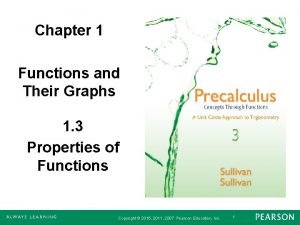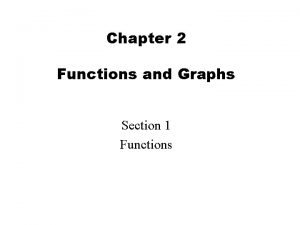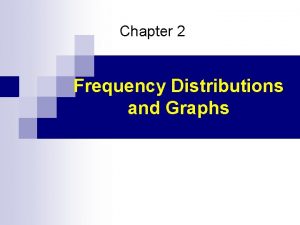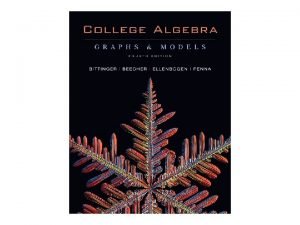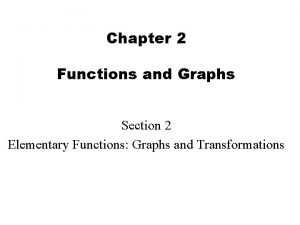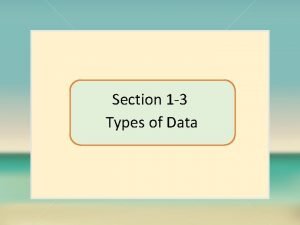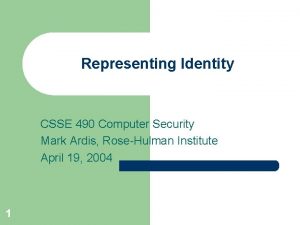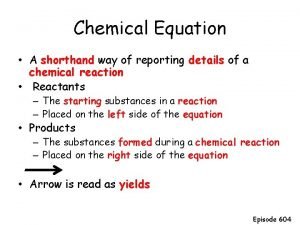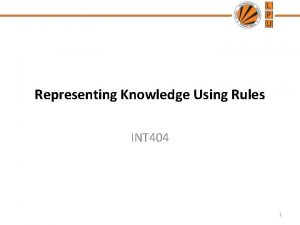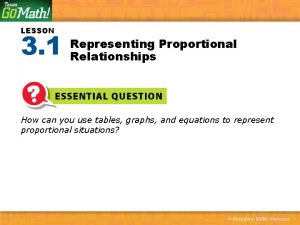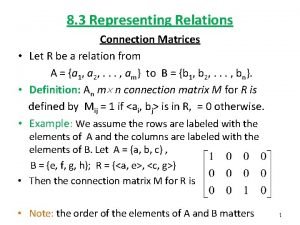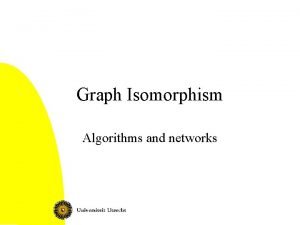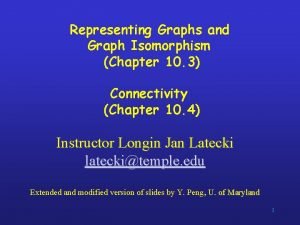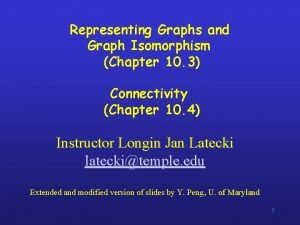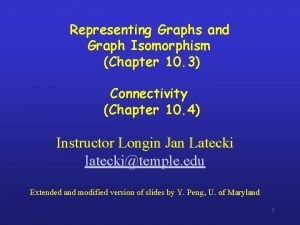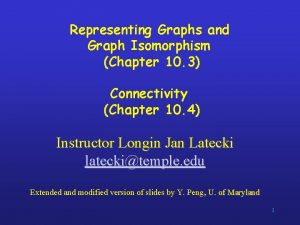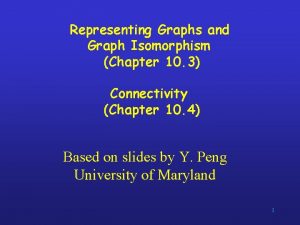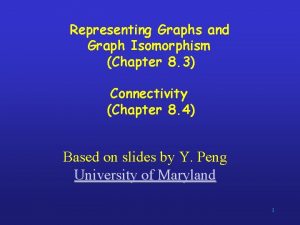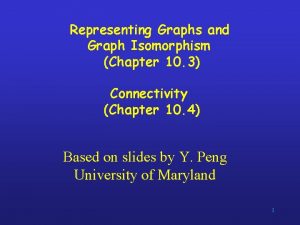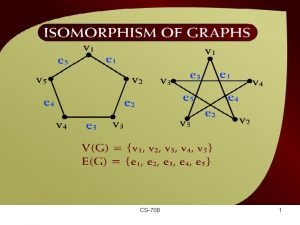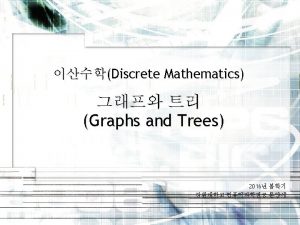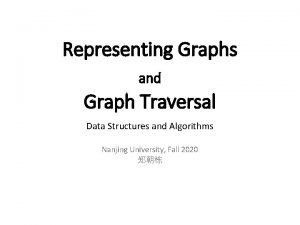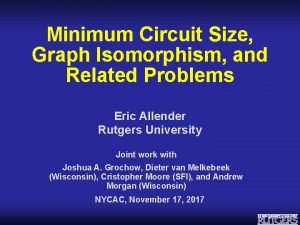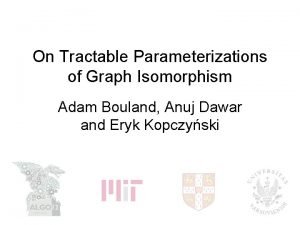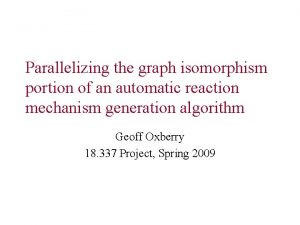Representing Graphs and Graph Isomorphism Chapter 10 3




















































- Slides: 52

Representing Graphs and Graph Isomorphism (Chapter 10. 3) Connectivity (Chapter 10. 4) Instructor Longin Jan Latecki latecki@temple. edu Extended and modified version of slides by Y. Peng, U. of Maryland 1

Representing Graphs a d d b c a Adjacency Lists Adjacent Vertex Vertices a b, c, d b a, d c a, d d a, b, c Initial Vertex a b c d b c Terminal Vertices c a a, b, c 2

Representing Graphs Definition: Let G = (V, E) be a simple graph with |V| = n (no two edges connect the same pair of vertices and each edge connects two different vertices). Suppose that the vertices of G are listed in arbitrary order as v 1, v 2, …, vn. The adjacency matrix A (or AG) of G, with respect to this listing of the vertices, is the n n zero-one matrix with 1 as its (i, j) entry when vi and vj are adjacent, and 0 otherwise. In other words, for an adjacency matrix A = [aij], aij = 1 aij = 0 if {vi, vj} is an edge of G, otherwise. 3

Representing Graphs Example: What is the adjacency matrix AG for the following graph G based on the order of vertices a, b, c, d ? a d b c Solution: Note: Adjacency matrices of undirected graphs are always symmetric. 4

Representing Directed Graphs Example: What is the adjacency d matrix AG for the following directed graph G based on the order of vertices a, b, c, d ? a b c Solution: 5

Representing Pseudographs Example: What is the adjacency matrix AG for the following preudograph G based on the order of vertices a, b, c, d ? Solution: 6

Representing Graphs Definition: Let G = (V, E) be an undirected graph with |V| = n. Suppose that the vertices and edges of G are listed in arbitrary order as v 1, v 2, …, vn and e 1, e 2, …, em, respectively. The incidence matrix of G with respect to this listing of the vertices and edges is the n m zeroone matrix with 1 as its (i, j) entry when edge ej is incident with vi, and 0 otherwise. In other words, for an incidence matrix M = [mij], mij = 1 mij = 0 if edge ej is incident with vi otherwise. 7

Representing Graphs Example: What is the incidence matrix M for the following graph G based on the order of vertices a, b, c, d and edges 1, 2, 3, 4, 5, 6? Solution: a 2 d 1 3 4 b 5 c 6 Note: Incidence matrices of undirected graphs contain two 1 s per column for edges connecting two vertices and one 1 per column for loops. 8

9

10

11

12

Isomorphism of Graphs Definition: The simple graphs G 1 = (V 1, E 1) and G 2 = (V 2, E 2) are isomorphic if there is a bijection (an one-to-one and onto function) f from V 1 to V 2 with the property that a and b are adjacent in G 1 if and only if f(a) and f(b) are adjacent in G 2, for all a and b in V 1. Such a function f is called an isomorphism. In other words, G 1 and G 2 are isomorphic if their vertices can be ordered in such a way that the adjacency matrices MG 1 and MG 2 are identical. 13

Isomorphism of Graphs Example I: Are the following two graphs isomorphic? a a b c e d c b e d Solution: Yes, they are isomorphic, because they can be arranged to look identical. You can see this if in the right graph you move vertex b to the left of the edge {a, c}. Then the isomorphism f from the left to the right graph is: f(a) = e, f(b) = a, f(c) = b, f(d) = c, f(e) = d. 14

Isomorphism of Graphs Example II: How about these two graphs? a a b e e b c c d d Solution: No, they are not isomorphic, because they differ in the degrees of their vertices. Vertex d in right graph is of degree one, but there is no such vertex in the left graph. 15

Isomorphism of Graphs From a visual standpoint, G 1 and G 2 are isomorphic if they can be arranged in such a way that their displays are identical (of course without changing adjacency). Unfortunately, for two simple graphs, each with n vertices, there are n! possible isomorphisms that we have to check in order to show that these graphs are isomorphic. The problem is not known to be solvable in polynomial time nor to be NPcomplete. However, showing that two graphs are not isomorphic can be easy. 16

Isomorphism of Graphs For this purpose we can check invariants , that is, properties that two isomorphic simple graphs must both have. For example, they must have • the same number of vertices, • the same number of edges, and • the same degrees of vertices. Note that two graphs that differ in any of these invariants are not isomorphic, but two graphs that match in all of them are not necessarily isomorphic. 17

Example Are these two graphs isomorphic? u 1 v 1 u 2 v 5 v 3 u 5 u 3 G u 4 H v 4 – They both have 5 vertices – They both have 8 edges – They have the same number of vertices with the same degrees: 2, 3, 3, 4, 4.

Example (Cont. ) G u 1 u 2 u 3 u 4 u 5 u 1 0 1 1 u 2 1 0 1 1 1 u 3 0 1 0 u 4 1 1 1 0 1 u 5 1 1 0 H G? H v 1 v 2 v 1 0 0 v 2 0 0 v 3 1 1 v 4 1 0 v 5 1 1 v 3 v 4 v 5 1 1 0 1 1 1 0 v 1 v 3 v 2 v 5 v 4 – G and H don’t appear to be isomorphic. – However, we haven’t tried mapping vertices from G onto H yet.

Example (Cont. ) Start with the vertices of degree 2 since each graph only has one: deg(u 3) = deg(v 2) = 2 therefore f(u 3) = v 2 u 1 v 1 u 2 v 5 v 3 u 5 u 3 G u 4 H v 4

Example (Cont. ) Now consider vertices of degree 3 deg(u 1) = deg(u 5) = deg(v 1) = deg(v 4) = 3 therefore we must have either one of f(u 1) = v 1 and f(u 5) = v 4 f(u 1) = v 4 and f(u 5) = v 1 u 1 v 1 u 2 v 5 v 3 u 5 u 3 G u 4 H v 4

Example (Cont. ) Now try vertices of degree 4: deg(u 2) = deg(u 4) = deg(v 3) = deg(v 5) = 4 therefore we must have one of: f(u 2) = v 3 and f(u 4) = v 5 f(u 2) = v 5 and f(u 4) = v 3 u 1 or v 1 u 2 v 5 v 3 u 5 u 3 G u 4 H v 4

Example (Cont. ) There are four possibilities (this can get messy!) f(u 1) = v 1, f(u 2) = v 3, f(u 3) = v 2, f(u 4) = v 5, f(u 5) = v 4 f(u 1) = v 4, f(u 2) = v 3, f(u 3) = v 2, f(u 4) = v 5, f(u 5) = v 1 f(u 1) = v 1, f(u 2) = v 5, f(u 3) = v 2, f(u 4) = v 3, f(u 5) = v 4 f(u 1) = v 4, f(u 2) = v 5, f(u 3) = v 2, f(u 4) = v 3, f(u 5) = v 1 u 1 v 1 u 2 v 5 v 3 u 5 u 3 G u 4 H v 4

Example (Cont. ) G u 1 u 2 u 3 u 4 u 5 u 1 0 1 1 u 2 1 0 1 1 1 u 3 0 1 0 u 4 1 1 1 0 1 u 5 1 1 0 H v 1 v 2 v 1 0 0 v 2 0 0 v 3 1 1 v 4 1 0 v 5 1 1 v 3 v 4 v 5 1 1 0 1 1 1 0 H’ v 1 v 3 v 2 v 5 v 4 v 1 0 1 1 v 3 1 0 1 1 1 v 2 0 1 0 v 5 1 1 1 0 1 v 4 1 1 0 We permute the adjacency matrix of H (per function choices above) to see if we get the adjacency of G. Let’s try: f(u 1) = v 1, f(u 2) = v 3, f(u 3) = v 2, f(u 4) = v 5, f(u 5) = v 4 Does G = H’? Yes!

Example (Cont. ) G u 1 u 2 u 3 u 4 u 5 u 1 0 1 1 u 2 1 0 1 1 1 u 3 0 1 0 u 4 1 1 1 0 1 u 5 1 1 0 H v 1 v 2 v 1 0 0 v 2 0 0 v 3 1 1 v 4 1 0 v 5 1 1 v 3 v 4 v 5 1 1 0 1 1 1 0 H’ v 4 v 3 v 2 v 5 v 1 v 4 0 1 1 v 3 1 0 1 1 1 v 2 0 1 0 v 5 1 1 1 0 1 v 1 1 1 0 It turns out that f(u 1) = v 4, f(u 2) = v 3, f(u 3) = v 2, f(u 4) = v 5, f(u 5) = v 1 also works.

Examples Determine if the following two graphs G 1 and G 2 are isomorphic: 26

Examples Determine if the following two graphs G 1 and G 2 are isomorphic: 27

Connectivity Definition: A path of length n from u to v, where n is a positive integer, in an undirected graph is a sequence of edges e 1, e 2, …, en of the graph such that e 1 = {x 0, x 1}, e 2 = {x 1, x 2}, …, en = {xn-1, xn}, where x 0 = u and xn = v. When the graph is simple (no two edges connect the same pair of vertices and each edge connects two different vertices), we denote this path by its vertex sequence x 0, x 1, …, xn, since it uniquely determines the path. The path is said to pass through or traverse x 1, x 2, …, xn-1. 28

Connectivity Definition: The path is a circuit if it begins and ends at the same vertex, that is, if u = v. A path or circuit is simple if it does not contain the same edge more than once. 29

Paths Example : In the simple graph here: – a, d, c, f, e is a simple path of length 4. – d, e, c, a is not a path because e is not connected to c. – b, c, f, e, b is a circuit of length 4. – a, b, e, d, a, b is a path of length 5, but it is not a simple path.

Paths in Acquaintanceship Graphs Example: In an acquaintanceship graph there is a path between two people if there is a chain of people linking these people, where two people adjacent in the chain know one another. In this graph there is a chain of six people linking Kamini and Ching. Some have speculated that almost every pair of people in the world is linked by a small chain of no more than 6, or maybe 7 people. The play Six Degrees of Separation by John Guare is based on this notion.

Connectivity Let us now look at something new: Definition: An undirected graph is called connected if there is a path between every pair of distinct vertices in the graph. For example, any two computers in a network can communicate if and only if the graph of this network is connected. Note: A graph consisting of only one vertex is always connected, because it does not contain any pair of distinct vertices. 32

Connectivity Example: Are the following graphs connected? a b e e d d c c Yes. No. b a a b e d e c d f c No. Yes. 33

Connectivity Definition: A graph that is not connected is the union of two or more connected subgraphs, each pair of which has no vertex in common. These disjoint connected subgraphs are called the connected components of the graph. Definition: A connected component of a graph G is a maximal connected subgraph of G. E. g. , if vertex v in G belongs to a connected component, then all other vertices in G that are connected to v must also belong to that component. 34

Connectivity Example: What are the connected components in the following graph? d a b i c e f g h j Solution: The connected components are the graphs with vertices {a, b, c, d}, {e}, {f}, {i, g, h, j}. 35

Connectivity Definition: A directed graph is strongly connected if there is a path from a to b and from b to a whenever a and b are vertices in the graph. Definition: A directed graph is weakly connected if there is a path between any two vertices in the underlying undirected graph. 36

Connectivity Example: Are the following directed graphs strongly or weakly connected? a b d a d c b c Weakly connected , because, for example, there is no path from b to d. Strongly connected , because there are paths between all possible pairs of vertices. 37

The Connected Components of the Web Graph Recall that at any particular instant the web graph provides a snapshot of the web, where vertices represent web pages and edges represent links. According to a 1999 study, the Web graph at that time had over 200 million vertices and over 1. 5 billion edges. (The numbers today are several orders of magnitude larger. ) The underlying undirected graph of this Web graph has a connected component that includes approximately 90% of the vertices. There is a giant strongly connected component (GSCC) consisting of more than 53 million vertices. A Web page in this component can be reached by following links starting in any other page of the component. There are three other categories of pages with each having about 44 million vertices: – pages that can be reached from a page in the GSCC, but do not link back. – pages that link back to the GSCC, but can not be reached by following links from pages in the GSCC. – pages that cannot reach pages in the GSCC and can not be reached from pages in the GSCC.

How connected is a graph? Cut vertices and edges If one can remove a vertex (and all incident edges) and produce a graph with more components, the vertex is called a cut vertex or articulation point. Similarly if removal of an edge creates more components the edge is called a cut edge or bridge. 39

In the star network the center vertex is a cut vertex. All edges are cut edges. In the graphs G 1 and G 2 every edge is a cut edge. In the union, no edge is a cut edge. 40 Vertex e is a cut vertex in all graphs.

EXAMPLE: Find the cut vertices and cut edges in the graph G 1. Solution: The cut vertices of G 1 are b, c, and e. The removal of one of these vertices (and its adjacent edges) disconnects the graph. The cut edges are {a, b} and {c, e}. Removing either one of these edges disconnects G 1. 41

Not all graphs have cut vertices. For example, the complete graph Kn, where n ≥ 3, has no cut vertices. When you remove a vertex from Kn and all edges incident to it, the resulting subgraph is the complete graph Kn− 1, a connected graph. K 5 K 4 42

Connected graphs without cut vertices are called nonseparable graphs , and can be thought of as more connected than those with a cut vertex. We can extend this notion by defining a more granulated measure of graph connectivity based on the minimum number of vertices that can be removed to disconnect a graph. 43

A subset S of the vertex set V of G = (V , E) is a vertex cut, or separating set, if V − Sis disconnected. We define the vertex connectivity of a noncomplete graph G, denoted by κ(G), as the minimum number of vertices in a separating set. When G is a complete graph, we set κ(Kn) = n − 1. Hence, for every graph G, κ(G) is minimum number of vertices that can be removed from G to either disconnect G or produce a graph with a single vertex. We have 0 ≤ κ(G) ≤ n − 1 if G has n vertices, κ(G) = 0 if and only if G is disconnected or G = K 1, 44 and κ(G) = n − 1 if and only if G is complete.

EXAMPLE: Find the vertex connectivity for each of the graphs: Solution: Because G 1 is a connected graph with a cut vertex, κ(G 1) = 1. Similarly, κ(G 2) = 1, because c is a cut vertex of G 2. G 3 has no cut vertices. but {b, g} is a separating set. Hence, κ(G 3) = 2. Similarly, G 4 has a separating set of size two, {c, f }, but no cut vertices. 45 It follows that κ(G 4) = 2.

The larger κ(G) is, the more connected we consider G to be. Disconnected graphs and K 1 have κ(G) = 0, connected graphs with cut vertices and K 2 have κ(G) = 1, graphs without cut vertices that can be disconnected by removing two vertices and K 3 have κ(G) = 2, and so on. We say that a graph is k-connected (or kvertex-connected) , if κ(G) ≥ k. A graph G is 1 connected if it is connected and not a graph containing a single vertex; a graph is 2 -connected, or biconnected, if it is nonseparable and has at least three vertices. Note that if G is a kconnected graph, then G is a j -connected graph for all j with 0 ≤ j ≤ k. 46

Counting Paths between Vertices Isomorphic graphs must have ‘the same’ paths. If one is a simple circuit of length k, then so must be the other. We can use the adjacency matrix of a graph to find the number of paths between two vertices in the graph. Theorem : Let G be a graph with adjacency matrix A with respect to the ordering v 1, … , vn of vertices (with directed or undirected edges, multiple edges and loops allowed). The number of different paths of length r from vi to vj equals the (i, j)th entry of Ar, where r >0 is a positive integer, Note: This is the standard power of matrix A, not a Boolean product. Proof is given below. First an example.

Example : How many paths of length four are there from a to d in the graph G. G adjacency matrix A of G A 4 = Solution : The adjacency matrix of G is given above. Hence the number of paths of length four from a to d is the (1, 4)th entry of A 4. The eight paths are as: a , b, d a , c , a , b, d a , c , d , b, d a , b, a , c , d a , b, d , c , d a , c, a, c, d a , c , d

Example 2 49

Theorem : Let G be a graph with adjacency matrix A with respect to the ordering v 1, … , vn of vertices. The number of different paths of length r from vi to vj equals the (i, j)th entry of Ar where r >0 is a positive integer. Proof by mathematical induction: Basis Step: By definition of the adjacency matrix, the number of paths from vi to vj of length 1 is the (i, j)th entry of A. Inductive Step: For the inductive hypothesis, we assume that the (i, j)th entry of Ar is the number of different paths of length r from vi to vj. Because Ar+1 = Ar A, the (i, j)th entry of Ar+1 equals (Ar+1)ij = bi 1 a 1 j + bi 2 a 2 j + ⋯ + binanj, where B = Ar and hence bik is the (i, k)th entry of Ar. By the inductive hypothesis, bik is the number of paths of length r from vi to vk for some vk Now akj is the number of edges from vk to vj.

A path of length r + 1 from vi to vj through vertex vk is made up of a path of length r from vi to vk , and an edge from vk to vj. By the product rule for counting, the number of such paths is the product of the number of paths of length r from vi to vk (i. e. , bik ) and the number of edges from vk to vj (i. e, akj). The sum over all possible intermediate vertices vk is (Ar+1)ij = bi 1 a 1 j + bi 2 a 2 j + ⋯ + binanj. Hence the (i, j)th entry of Ar+1 is the number of different paths of length r+1 from vi to vj.

Example : Use theorem on the previous slide to show that graph G is connected and graph H is not connected. adjacency matrix A of G G H Solution : Theorem. Graph G with n nodes is connected iff every entry n-1 is positive, where A is the of I+A+A 2+A 3+· · ·+A adjacency matrix of G.
 Representing graphs and graph isomorphism
Representing graphs and graph isomorphism Representing graphs and graph isomorphism
Representing graphs and graph isomorphism Directed pseudograph
Directed pseudograph Graph isomorphism
Graph isomorphism Graph isomorphism network
Graph isomorphism network State graph in software testing
State graph in software testing Graphs that enlighten and graphs that deceive
Graphs that enlighten and graphs that deceive Chapter 2 representing motion chapter assessment
Chapter 2 representing motion chapter assessment Networks and graphs: circuits, paths, and graph structures
Networks and graphs: circuits, paths, and graph structures Grup abelian
Grup abelian Isomorphism
Isomorphism Neural subgraph isomorphism counting
Neural subgraph isomorphism counting Isomorphism vector space
Isomorphism vector space Isomorphism
Isomorphism Isomorphism 線性代數
Isomorphism 線性代數 Isomorphism
Isomorphism Tobias harding
Tobias harding Comparing distance/time graphs to speed/time graphs
Comparing distance/time graphs to speed/time graphs Polynomial function form
Polynomial function form Algorithmic graph theory and perfect graphs
Algorithmic graph theory and perfect graphs Picturing motion physics
Picturing motion physics What is the purpose of drawing a motion diagram
What is the purpose of drawing a motion diagram Inverse variation
Inverse variation Resource allocation graph and wait for graph
Resource allocation graph and wait for graph Represented speech examples
Represented speech examples Representing comparing and ordering decimals
Representing comparing and ordering decimals Vector arrows representing the vx and vy
Vector arrows representing the vx and vy Lesson 6.1 identifying and representing functions
Lesson 6.1 identifying and representing functions Output knowledge
Output knowledge 11 interpreting graphics answers
11 interpreting graphics answers Frequecy polygon
Frequecy polygon Chapter 1 functions and their graphs
Chapter 1 functions and their graphs Chapter 2 functions and graphs
Chapter 2 functions and graphs Chapter 2 functions and their graphs answers
Chapter 2 functions and their graphs answers Chapter 2: frequency distributions and graphs answers
Chapter 2: frequency distributions and graphs answers Chapter 1 graphs functions and models answers
Chapter 1 graphs functions and models answers Chapter 2 functions and graphs
Chapter 2 functions and graphs Line graph graph theory
Line graph graph theory It consists of numbers representing counts or measurements
It consists of numbers representing counts or measurements Representing identity in information security
Representing identity in information security Nejime definition floral design
Nejime definition floral design Animals that represent chaos
Animals that represent chaos Chemist shorthand way of representing chemical reaction
Chemist shorthand way of representing chemical reaction A chemist shorthand
A chemist shorthand Representing motion
Representing motion A chemist shorthand way of presenting chemical reaction
A chemist shorthand way of presenting chemical reaction Representing knowledge using rules
Representing knowledge using rules Representing relations using digraphs
Representing relations using digraphs Lesson 3-1 representing proportional relationships
Lesson 3-1 representing proportional relationships Representing relations using digraphs
Representing relations using digraphs Ways of representing functions
Ways of representing functions Representing knowledge in an uncertain domain
Representing knowledge in an uncertain domain Meaning:representation
Meaning:representation
